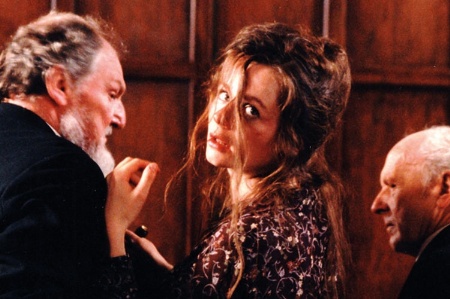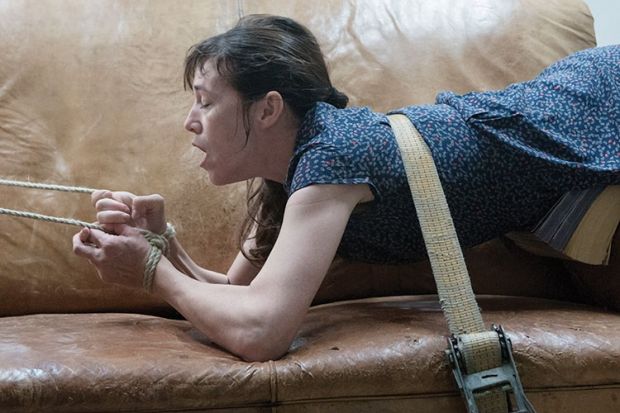Source: Christian Geisnaes
Nymphomaniac: ‘inviting viewers into a realm of raw physicality and unhinged psychological states, von Trier’s “unpleasurable” cinema is entirely characterised by his awareness of our compulsion to care’
Nymphomaniac, Volumes 1 and 2
Written and directed by Lars von Trier
Starring Charlotte Gainsbourg, Stellan Skarsgård and Stacy Martin
On general release in the UK from 22 February
Von Trier’s cinema is traumatic not simply because it is shocking or perverse, but because our investment in the subjects of his films is so great
It is difficult to imagine a greater kind of cinematic trauma, a greater assault on the senses, than that prompted by the work of Lars von Trier. The Danish auteur is best known as a cultivator of “extreme cinema”, an agent of acute provocation, not to mention disgust. But such labels do little to unravel a body of work that scholar Caroline Bainbridge, one of the foremost analysts of his films, characterises as the cinema of “unpleasure”. With the imminent release of Nymphomaniac, a two-“volume” story of a woman’s obsession with sex, it is timely to draw closer attention to his particular style of film-making and his most indelible masterpieces.
Indeed, the uncensored trailer for Nymphomaniac seems to invite viewers into a realm of raw physicality and unhinged psychological states reminiscent of much of von Trier’s most emotive and evocative work. It is in such moments that von Trier’s “unpleasurable” cinema is entirely characterised by his awareness of our compulsion to care.
In the final moments of Breaking the Waves (1996), a naive young woman, Bess (played by Emily Watson), is transported on a small boat towards a pirate ship, dressed in crimson PVC hot pants and fishnet tights, garishly made-up and teetering in high heels. In the scenes leading up to this one, she has been having sex with strangers as part of a bizarre ritual, a pact with God, that she believes will heal her crippled husband, Jan. When Jan’s condition does not improve, she knowingly enters the den of a sadist and is brutally attacked, sacrificing her life in return for Jan’s.
As she moves towards the ship and her violent end, Bess is filmed in close-up, her face streaked with tears, eyes wide and despairing. Viewers listen to her every breath and watch strands of her hair blow in the wind, so close to Bess that we are forced to examine her every expression, intimately attached to her. Indeed, just as Bess sighs as she makes the crossing towards the ship, von Trier adopts a formal gesture in order to underpin her emotional state: the image itself appears to falter, slipping slightly out of focus before recovering composure. (Although one might argue that this is merely characteristic of the film’s hand-held camerawork, the alteration in the depth of focus seems deliberate, designed to invoke the very kind of mental and physical disorientation felt by the film’s heroine.)
The way in which we care about Bess owes much to the fact that von Trier encourages viewers to participate actively in the ethics of his narratives. While much has been written about his involvement with Thomas Vinterberg in the Dogme 95 movement (which aimed to strip away the artifice of film through the exclusion of sets, props, non-location sound and so on), it is the intensity with which he examines his protagonists’ moral choices, the representation of their selfhood and their impassioned lives that propels viewers towards an intimate kind of film spectatorship. His cinema is traumatic not simply because it is shocking or perverse, but because our investment in the subjects of his films is so great.

Certainly, von Trier’s iconic close-ups of Bess in Breaking the Waves evoke the images of suffering in Carl Theodor Dreyer’s 1928 silent masterpiece, The Passion of Joan of Arc. Like Dreyer’s film, von Trier’s loosely linked Golden Heart trilogy, which is the work I consider to be his best, explores virtue and sacrifice, female suffering and selfhood. Their narratives have attracted criticism, chiefly because of their seemingly sadistic treatment of women, but this oversimplifies their complex exploration of ethics, in particular. While each of the women in the Golden Heart films endures terrible hardships, all remain staunchly faithful to doing what they believe to be right – and this is where the power of each film lies. We are utterly undone by one haunting question: would we be able to do the same?
As in Breaking the Waves, the last scene of The Idiots (1998), von Trier’s first Dogme film, is devastating not only because viewers are so deeply embedded in the film experience, but because we care about the protagonist, Karen, in a way that goes beyond any Hollywood conception of identification. Karen reluctantly joins a group of people experimenting with social expectations, namely by pretending to be disabled, referred to in the film as “spassing”. Yet when she returns home to “test” her family, she goes much further than any of the others.
Karen’s reversion to an infant-like state of physical dysfunction begins with a slow drip of tea leaking from the side of her lipsticked mouth, then a small creamy lump of cake and drool reaching the edge of her chin. Throughout the film we have already seen spectacular examples of spassing in all manner of social situations, including an awkward scene in a men’s lavatory, but Karen’s attempt is exceptionally heartbreaking and traumatic because we know she is mourning the loss of her child and her fascination with spassing has offered her some kind of catharsis, perhaps finding freedom in becoming a child again.
The third film in von Trier’s Golden Heart trilogy, Dancer in the Dark (2000), focuses on a single mother named Selma (played by Björk). Like Bess and Karen, she endures many ethical dilemmas, but ultimately makes her own choices in spite of the likely consequences. Selma is sentenced to death for murder while also going blind, increasingly drifting off into a dream world in which life is playing out like a musical in saturated colours. Her execution is unbearable, not only because we see every moment as she is taken to be hanged, but because von Trier has connected us to her consciousness, her imaginary universe, her dreams.
This trilogy includes some of von Trier’s most radical and enduring cinematic moments. Recent films such as Antichrist (2009) and Melancholia (2011) do not contain within their DNA the same levels of catharsis and intimacy. Despite the echoes of his earlier work (the questioning of faith, the crisis of selfhood), they are only facsimiles. In Breaking the Waves, The Idiots and Dancer in the Dark, von Trier is closest to his own formulation of a socially and ethically implicated cinema, a style that demands much from the viewer but whose rewards are rich.
In the trailer for Nymphomaniac, the female protagonist, Joe (who is played at different ages by Stacy Martin and Charlotte Gainsbourg), bears a striking resemblance to Bess in the final scenes of Breaking the Waves. She is provocatively dressed in exactly the same kinky ensemble of shiny red hot pants and overstretched fishnet tights. Could von Trier be staging a return to his most affecting work and the empathetic women of the Golden Heart trilogy? Viewers will get an opportunity to decide for themselves from 22 February, when selected cinemas will screen both volumes, with live satellite links to a question-and-answer session with cast and crew, to kick off the general release of the films in the UK.
Register to continue
Why register?
- Registration is free and only takes a moment
- Once registered, you can read 3 articles a month
- Sign up for our newsletter
Subscribe
Or subscribe for unlimited access to:
- Unlimited access to news, views, insights & reviews
- Digital editions
- Digital access to THE’s university and college rankings analysis
Already registered or a current subscriber? Login

